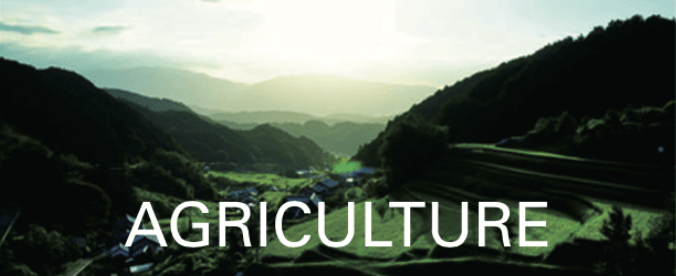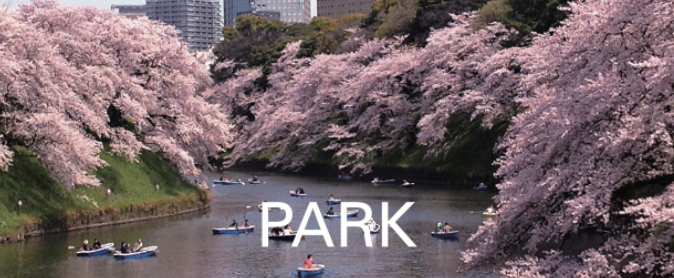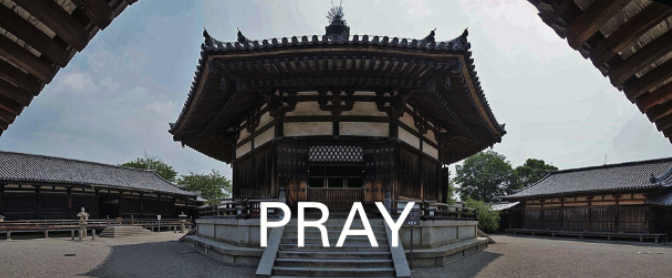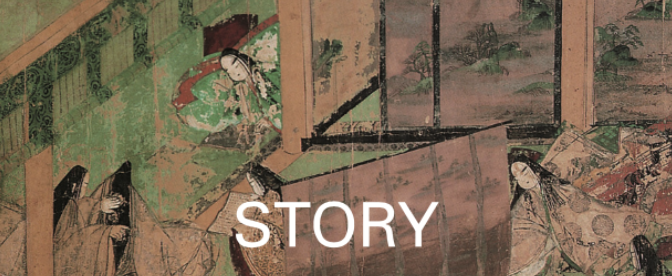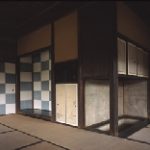
This is a villa of the Katsuranomiya family, built by Prince Hachijo Toshihito: the grandson of Emperor Ogimachi (1517 – 1593) and the founder of the Katsuranomiya family, during the Edo period. The garden and architecture at the time of construction remains.
There is a Japanese style garden with a path around a central pond, which draws water from the Katsura River, and where teahouses and artificial hills around a pond are laid out. Shoin, the drawing room, is based on the Shoin Zukuri, a style of Japanese residential architecture used in the samurai and temple guest halls, and taken in the Sukiya, a style of a tea-ceremony arbor.
Eventually, that style is Karomi, without persistence. After Prince Hachijo was adopted by Toyotomi Hideyoshi (1537 – 1598), the powerful feudal lord and Imperial Regent who unified Japan, Hideyoshi had his real child. Though Prince Hachijo returned to the Imperial family, he could not succeed to the throne. He became the founder of the Katsuranomiya family.
The Karomi style of the prince is like Bamboo with its flexibility and straightness.
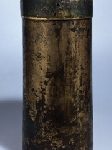
The museum opened in 1897 as the Imperial Kyoto Museum, in a Western-style one-story building, which was designed by court architect Katayama Tokuma (1854 – 1917). It exhibits many cultural assets showing the culture of the old capital from the Heian period (794 – 1185) to the Edo period (1603 – 1868).
It includes works, such as the National Treasure Gilt bronze Kyozutu, scripture cylinder, of Fujiwara no Michinaga – a cylindrical container in which sacred scriptures are placed, made of malleable bronze with plating.
Fujiwara no Michinaga (966 – 1028), a Regent controlling the sovereign through matrimonial links to the Emperor, buried this Kyozutu. Later, Fujiwara no Shoshi, the eldest daughter of Fujiwara no Michinaga, married Emperor Ichijou (980 – 1011) and had a long-awaited Imperial prince, Emperor Goichijo (1008 – 1036).
In this way, the museum safely stores and manages valuable items in other facilities, including national treasures and important cultural properties. This contract work is also an important role for this museum.
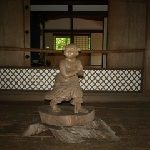
This temple possesses valuable arts and crafts, such as the national treasure Choju Jinbutsu Giga, the illustrated handscrolls of frolicking animals and humans, the statue of Zenzai Doji, the child who traveled to 53 places, in search of wisdom described in the Buddhist texts.
This temple also has the tea garden that Eisai Zenji (1141 – 1215), a Japanese Buddhist priest who brought Rinzai Zen to Japan, used for the tea seeds he brought back from China. It is said to be the oldest one in Japan. This temple was founded by the order of Emperor Konin (709 – 781), and was opened by Myoe Shonin (1173 – 1232), a Japanese Monk, and the originator of the restoration of the Kegon Sect.
Shonin helped save the families of the loser, after the Jokyu Disturbance in 1221, the fight between the retired Emperor and the Kamakura Shogunate. It is said that Ishimizu-in Temple was the residence of Myoe Shonin, which has a roof covered with shingles only, and the style Shinden Zukuri, an architectural style of nobles’ residence, at the beginning of Kamakura period (1185 – 1333).
It reminds us of the style of the courtier at that time.
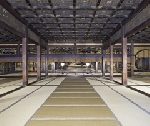
This temple is the head temple of the Jodo-Shin sect (True Pure Land sect) Hongaji School. Konoma, is the reception hall which is a large 203 tatami mat room. The wall painting on the Konoma, Jodan (place of honor), was painted by Watanabe Ryokei (Died 1645), who was the representative painter in the Azuchi-Momoyama period (1573 – 1603), and in the beginning of the Edo period (1603 – 1868).
Ryokei learned the methods of painting under Kanou Mitsunobu (1565 – 1608), who was a head of the Kanou school and painted delicate flowers and birds in a composition with a natural depth.
The aesthetic of the splendid and profound taste is fadeless over 400 years, and overlaps the hardship history of this sect that had survived the Age of Provincial Wars in the 15th – 16th centuries, and returned to Kyoto after Hokuriku region, and Osaka.
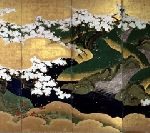
Kasuga Taisha shrine was founded in 768 as a guardian deity of Heijyoukyou, the ancient capital Nara. During the Heian period in the 9th – 12th centuries, the imperial family and aristocracies dedicated many treasures to this shrine, and this museum is referred to as Shosoin, treasure house at Todaiji Temple in Nara, built in the middle of the 8th century, in the Heian period.
This museum possesses the Kasuga gongen genki-e, illustrated scrolls of incarnations at Kasuga shrine, which has an extremely elaborate and brightly colored description, about events that occurred by the god and dream scenes.
The National Treasure, Decorative sword, with Black-lacquered mounting wreathed with strips, was used for ceremonies. It has Nakago, the part that holds the hilt of a straight sword with a double edge.

In the Nara period (710 – 794) and the Heian period (794 – 1185), government offices and the Great Temple had Shoso, Treasure Houses for important goods. Some districts brought together several Shoso, called Shosoin. The Shosoin preserved the treasures of Emperor Shomu and Empress Komyou.
These treasures were managed by Todaiji temple under the Imperial Court jurisdiction for over 1000 years. Today, Shosoin is managed directly by the Imperial Household Agency, in view of the importance of the treasures.
The Shosoin Exhibition is held once a year at the Nara National Museum, and dozens of these treasures are exhibited solely for this event.
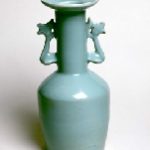
This museum holds various planned exhibitions six times a year, which center on Oriental antiquities. It possesses Ukiyoe, Japanese woodblock prints, Western modern art, and old maps. It has a Japanese garden, tea room, music hall, and creative classroom connected to the museum, providing a base for cultural activities in Izumi City.
It’s possessions include Houomimihanaike, a Celadon glazed vase with a handle of Hoo, a mythological sacred bird that drank from a sacred fountain and stayed at Aogiri, a Chinese parasol-tree. It is a work of the Southern Son Dynasty (1127 – 1279), and the glaze of Funseishoku, a moist and calm blue, was thickly applied to the grayish white porcelain that contains some iron content.
This vase was once given to the Tokugawa Shogunate, Toufukumon’in Masako (1607 – 1678), a daughter of Tokugawa Hidetada, the 2nd Shogun and Chugu, (second consort of the emperor) (1625 – 1629) of the Emperor Go-Mizuno (1596 – 1680), and Emperor Go-Sai (1633 – 1654).
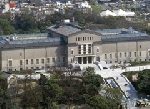
The main building of this museum, which was built with the hybrid style of Japanese-Western design, was registered as a registered tangible cultural properties in 2015.
This museum’s collection contains about 8,500 items including paintings, sculptures, crafts, etc. from Japan and China.
This museum has two worldwide collections: the collection of Abe Fusajiro (1868 – 1937) of Chinese paintings and calligraphies, and the collection of Yamaguchi Kenshiro (1886 – 1957) of Chinese Buddhist sculptures.
Its collections are also a wide variety of content such as: materials related to Ogata Korin (1658 – 1743), a Japanese painter, lacquerer and designer of the Rinpa school, Netsuke, a carved Japanese ornament, Inro, a pillbox, and modern paintings.
—This museum is located in the Tennoji Park. The Transmission of Buddhism — the official introduction of Buddhism to Japan — was held at Naniwa Osaka, in the 6th century. Shitennoji Temple was built at Naniwa Osaka by the Prince of Shotoku (574 – 627) in the Asuka period (550 -710), which was the oldest Kanji, state-sponsored temples. Tennoji Park is derived from the Shitennoji Temple.

The Himeji City Museum of Art introduces the works of great artists associate with Himeji.
Matsuoka Eikyu (1881 – 1938), was the younger brother of Yanagita Kunio (1875 – 1962), a scholar and the father of Japanese native folkloristics. He studied painting at the Japanese painting department of the Tokyo School of Fine Art, and expressed modernity using Yamato-e, classical Japan decorative paintings.
He was also passionate about the restoration of Yamato-e, with outstanding artistic power. His art work of Tokudaiji Itsukushima Mode, to make a pilgrimage to the Itsukushima Island, came from volume 2 of the Tale of the Heike, Narrative poetry of the struggle between the Taira clan and Minamoto clan for control of Japan, at the end of the 12th century. Tokudaiji Sanetada (1139 – 1192) did not get the desired position in the Imperial Court. Along the recommendation of a person, Sanetada made a pilgrimage to the Itsukushima Island, which was worshipped well by Taira no Kiyomori (1118 – 1181), a head of the Heike (Taira) clan, who established the first samurai dominated administrative government in Japan. Kiyomori was very pleased, when he heard of the pilgrimage. And he gave a good position in the Imperial Court to Sanetada. This was the story of the Tale of the Heike.
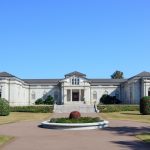
This museum shows the history of the Ise Jingu Shrine Removal and the Imperial court ceremony here. “Ranomurasakino Onsashiha”is like a “red purple Ayano Silk Tent”, which was held over the noblemen, similar to a Sachiba (fan) or a Kinugasa (parasol). It displays a model of clay images and that were painted on the walls of Takamatsuzuka, an ancient tomb from the Tumulus period (3-7th century).
The “Ranomurasakino Onsashiha” was made with a special method to intertwine the warp and the weft to create a see-through silk cloth. The succession was interrupted by the Onin War (1467 – 1477), the controversy over the successor of the Ashikaga Shogunate, between Hosakawa Katsumoto (1430 – 1473), Ashikaga Shogun’s deputy, and Yamana Sozen (1404 – 1453), the Shugo, Governor of Provinces in the western part of Japan.
Living national treasure, Itagawa Heiro (1898 – 1988), a Japanese Dyeing and Weaving artisan, restored it.
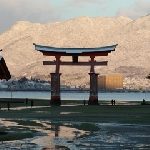
This big Torii is a beauty system that shows harmony with nature, and the wisdom of 800 years ago. The present Torii is the 8th generation, which stands with its own weight without being buried deeply into the sand of the Sea.
The upper box-shaped Shimagi, beam under the roof is packed with 4 tons of fist-sized cobble stones. 6 pillars, including the main pillars, and Sodebashira, small pillars supporting the main pillars of the Torii, and the roof are connected by wedges, which absorb movement and distortion.
In the bottom of the sea, piles of pine wood were driven, to reinforce the ground, and Fuseki, continuous stones, were placed to make a foundation.
*The big Torii is currently under restoration work.
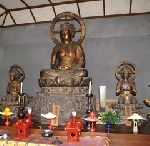
The statues at this temple of the Buddha triad, Buddha attended by two Bosatsus, were made in the Heian period (794 – 1185). The main seated statue is the image of Amida Nyorai, Amitabha, the principal image of Buddha in Pure Land. It sits in Ketsukafuza, Lotus position, with legs crossed for meditation practice.
It is 139.1 cm tall and its face appears refined and splendid, well-balanced, with the soft, drape-like sculpting style. All three statues are made in Yosegi Zukuri, the technique of assembling wood blocks, after being treated and craved, and made of cypress wood. These were made in the Fujiwara era of Kokufu Bunka, Japan’s original national culture (894 – 1185).
Those statues were originally Amida Goson-zo, 5 statues: the statue of Amida Nyorai with 4 attended statues. This Buddha triad, which used to have the two statues of Jizo Bossatsu, a guardian deity of travelers and children, and Ryuju Bossatsu, the priest and scholar existed around 150-250 years from South India, who established early Mahayana Buddhism. Those are currently in the possession of Nara National Museum. It is the only surviving statues of Amida Goson-zo from the Heian period.



